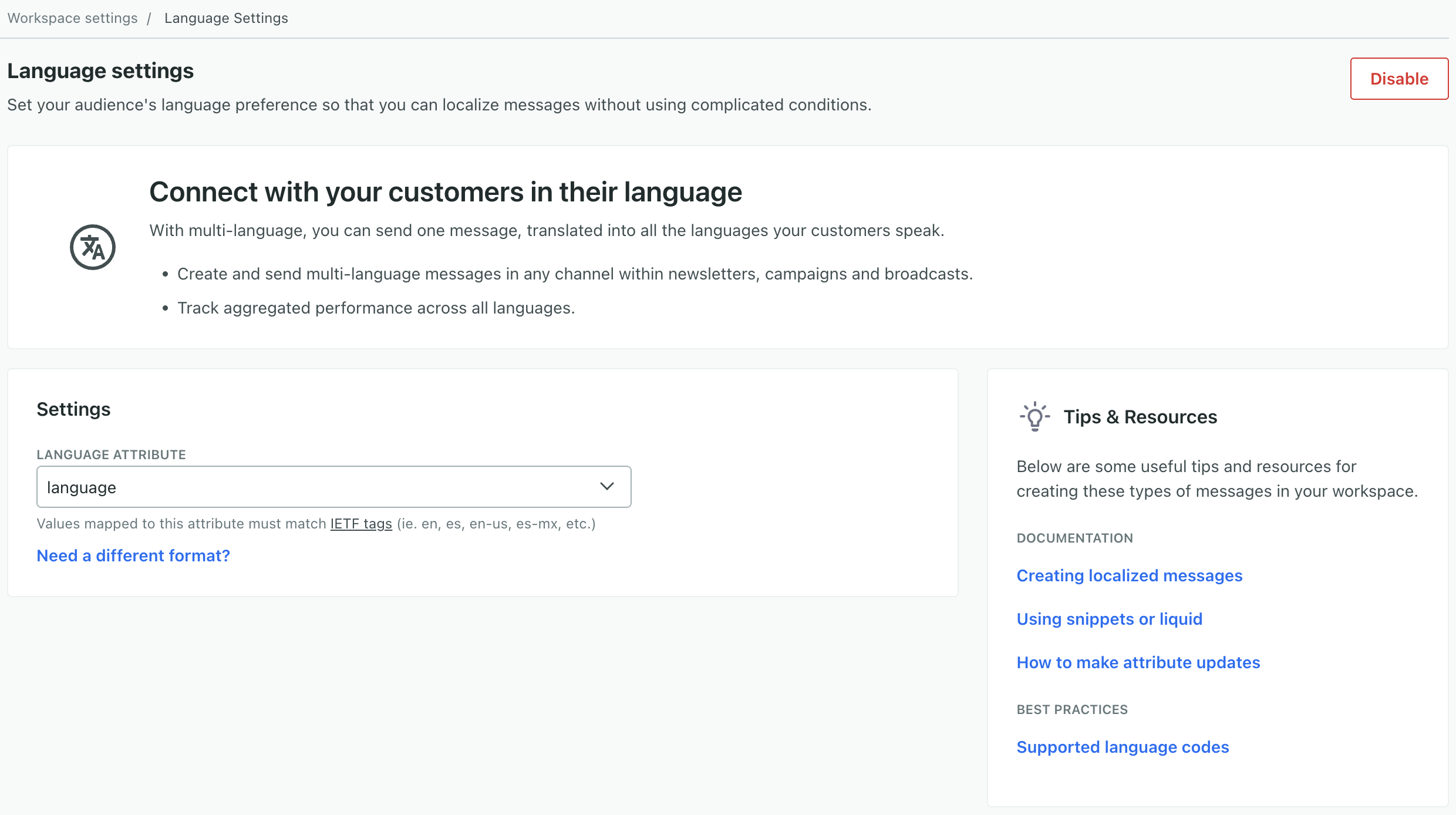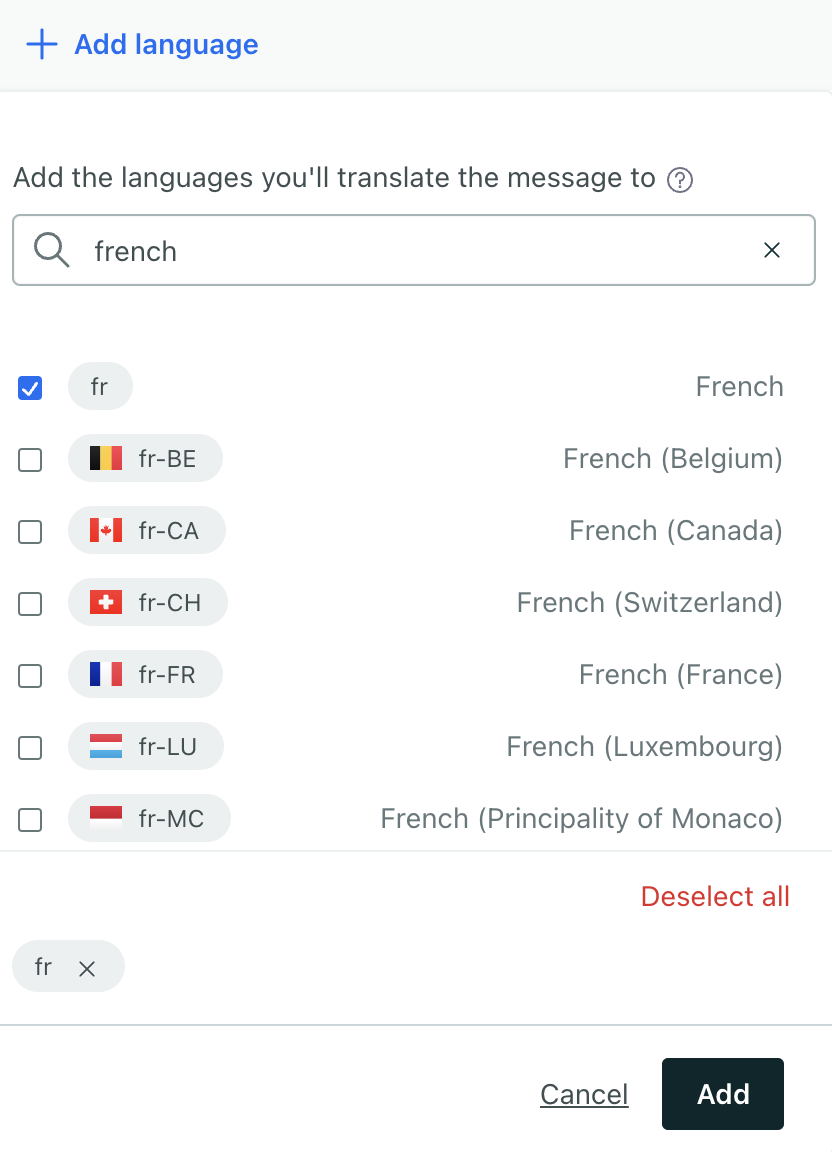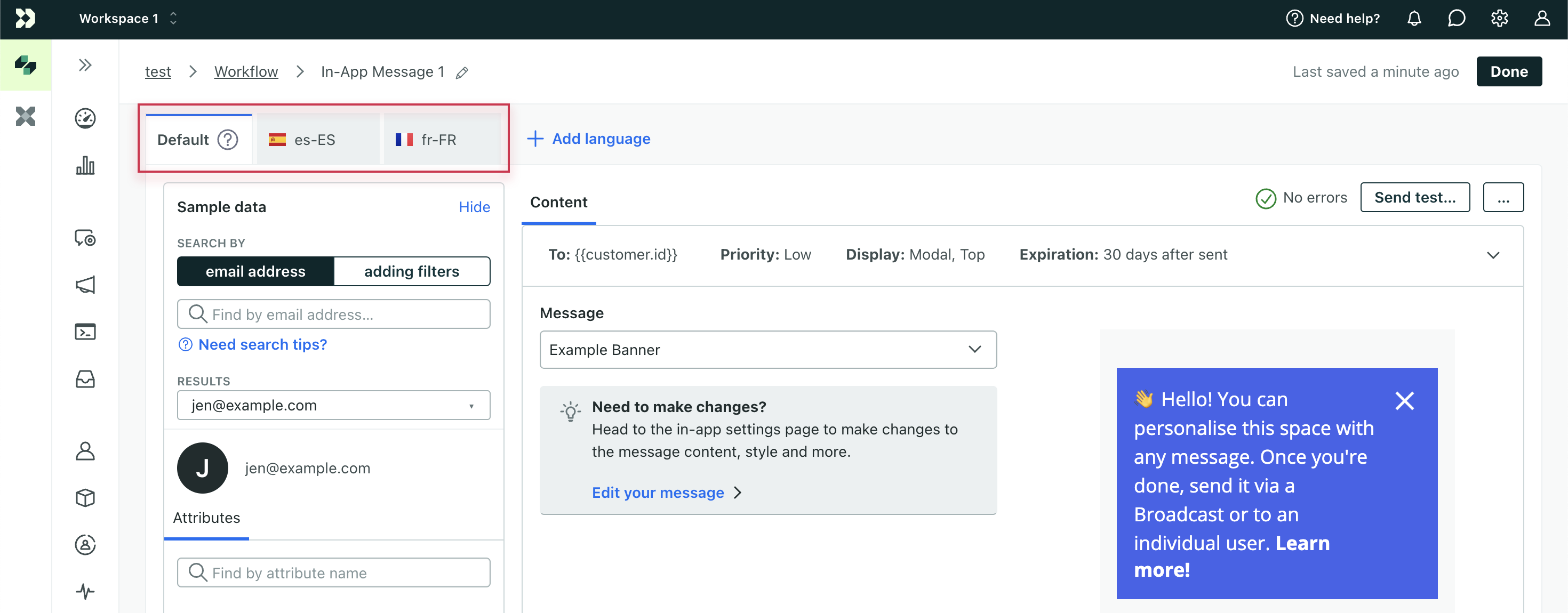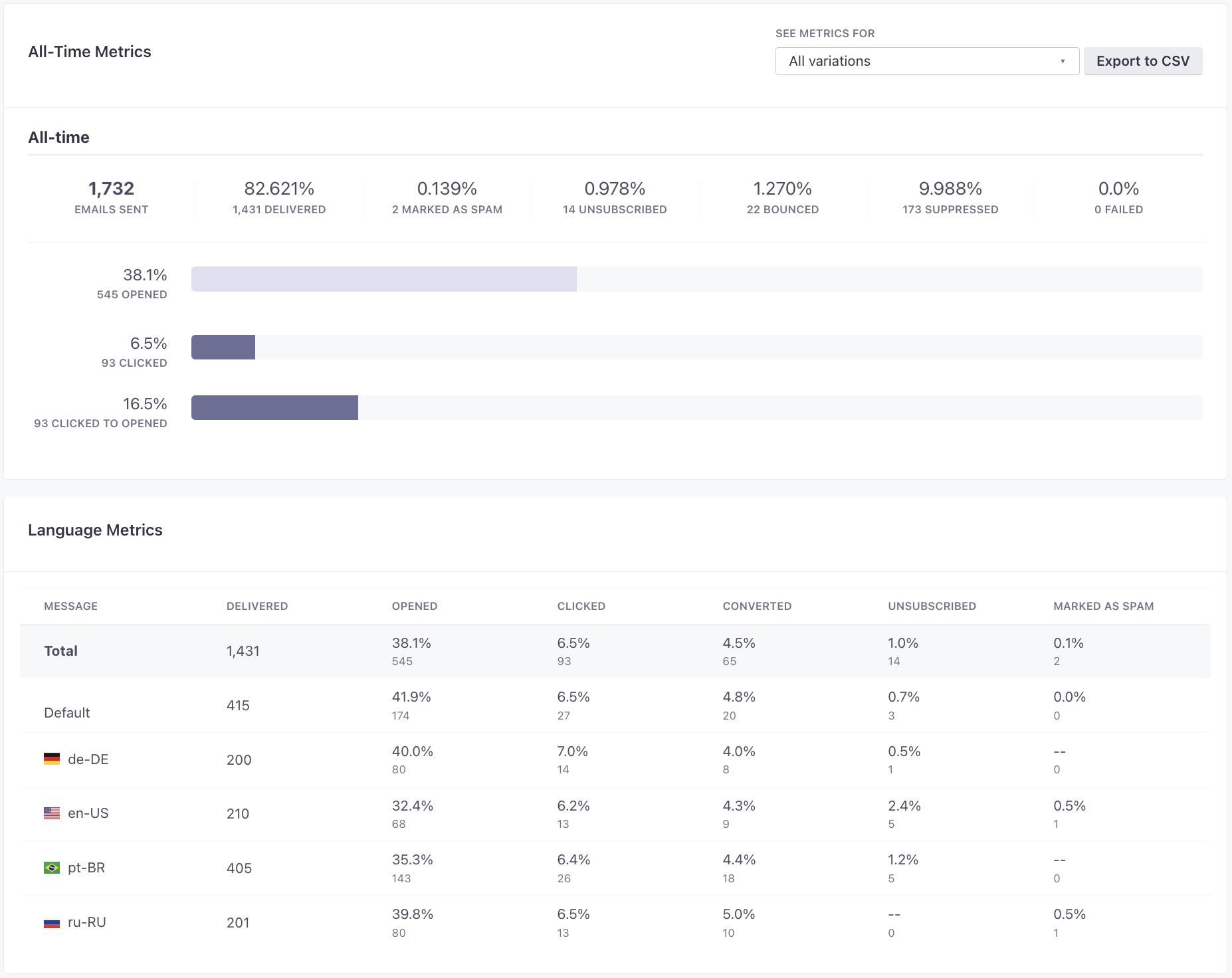Getting started
You can store your audience’s language preferences as an attribute, and then use that attribute to send people messages in their preferred language!
How it works
When you add or update people, you can set an attributeA key-value pair that you associate with a person or an object—like a person’s name, the date they were created in your workspace, or a company’s billing date etc. Use attributes to target people and personalize messages. Attributes are analogous to traits in Data Pipelines. containing their language preference. Then, when you set up messages, you can click Add language to add one or more languages. You’ll set up your Default message, and then add content for each language.
When you send your message, people whose language attribute matches one of your message’s languages will receive the appropriate localization. Everybody else receives the Default message.
attribute] --> B[Set up
multi-language message] B --> C[Send
message] C --> D{Does a person's language
attribute match a message?} D -->|no| H[Person gets
default message] D -->|yes, lang=es| E[Person gets
Spanish message] D -->|yes, lang=fr| F[Person gets
French message] D -->|yes, lang=de| G[Person gets
German message]
Multi-language support
| Campaign/Message Type | SMS | Push | In-App | |
|---|---|---|---|---|
| Campaigns | ✅ | ✅ | ✅ | ✅ |
| Newsletters | ✅ | ✅ | ✅ | ✅ |
| Broadcasts | ✅ | ✅ | ✅ | ✅ |
| Transactional Messages | ✅ | ✅ |
Set your language attribute
Before you can send localized messages, you need to go to Settings > Workspace Settings > Localization and tell us what attributeA key-value pair that you associate with a person or an object—like a person’s name, the date they were created in your workspace, or a company’s billing date etc. Use attributes to target people and personalize messages. Attributes are analogous to traits in Data Pipelines. stores your audience’s language preferences. This attribute must store values we values we support, meaning they’re either:
- a two letter language code, like
enfor English - a four-letter language and region code, separated by a dash, like
en-USfor English speakers in the United States.


Set up a multi-language message
When you create a message with multiple languages, you should always begin by drafting your Default message. This is the message intended for anybody who doesn’t match another language, and should represent your “template” for other languages.
If you plan to send email contents to a translation vendor, you’ll want to set up and export your Default message first, and then add languages when you receive them. Check out our best practices for help exporting email messages for your translation vendor and the quickest way to add your multi-language content.
- Click Add language, select the languages you want to add, and click Add.


- Draft your Default message. This message should act as a “template” for your other languages.
- Add your content for your languages. Use the tabs at the top of the message to switch between languages.


- When you’re done, click Save & Next and finish setting up your newsletter.
Best practices
Export emails to HTML before you send them to a translation vendor
If you create your email with the drag and drop editor, you can go to Actions > Export to HTML to export your message as HTML, making it easy to send your message to translators.
If you use the code editor, you can just copy your email out to a separate file.
Make sure your translation vendor handles raw HTML
While we suggest you export custom HTML, make sure that your translation team can translate raw HTML before you export your email or switch editors. Remember, when you switch editor types, you cannot switch back.
Make sure attribute values that you reference with liquid are translated, or use if statements to set specific values.
You might use liquid to personalize your message for members of your audience. However, if your liquid values don’t reflect the languages your audience expects, members of your audience could see words they don’t recognize in their message.
If your attribute values aren’t translated, you could use an and operator to set hard-coded values for members of your audience whose attributes don’t reflect their language preference.
{% customer.
Exporting and importing multi-language emails
When you set up a message with multiple languages, you may need to send content to a translation vendor. To simplify this process, we suggest that you draft, test, and finalize your Default message first.
When you’re ready to send your message to translators, you can export a message from the drag and drop editor to HTML rather than copying out individual blocks of text. If you use the code editor, you can simply copy your HTML to a text file. This makes it easy to send your message to your translation partner.
when you receive your languages from your translator(s) it’s easy to copy and paste translated HTML back into the Code editor. If your message is completely finalized, and you don’t intend to edit it, exporting and importing HTML using the code editor is the easiest way to add languages to a message.
If you didn’t export your message’s HTML, or you want to use the drag and drop editor, you’ll need to paste localized text back into the blocks in your message. If you use the rich text editor, you may need to reformat text when you paste languages into the editor.
Make sure that your translator handles HTML
While exporting HTML is the easiest way to send your message to a translator, you should check with your translation vendor to make sure that they can translate HTML files.
message] -.->F{Test message} A -.-> |Convert without testing| C[Convert to
Custom HTML] C --> D[Export and
send to translator] D -->|Get translations
back| E[Add languages] E --> G[Send message] F-.-> |Tests pass|C F-.-> |Tests fail|A
Multi-language metrics
When you send a message with multiple languages, we show metrics for each language. These metrics can help you make sure that your messages perform well in all of your audience’s languages.


Supported languages and locales
Your language attribute’s values must be formatted as a two letter language code with an optional two-letter region code separated by a dash. For example, you might use en for English or en-US for English speakers in the United States.
Language attributes are not case sensitive, but language-region codes must be separated by a dash. For example, both es-MX and es-mx both represent Spanish formatted for speakers in Mexico.
These codes come from the ISO-3166-1 (alpha 2) and IETF standards respectively. If you’re looking for a language or locale that we don’t support, let us know!
| Language/Locale | Code |
| Afrikaans | af |
| Afrikaans (South Africa) | af-ZA |
| Amharic (Ethiopia) | am-ET |
| Arabic | ar |
| Arabic (U.A.E.) | ar-AE |
| Arabic (Bahrain) | ar-BH |
| Arabic (Algeria) | ar-DZ |
| Arabic (Egypt) | ar-EG |
| Arabic (Iraq) | ar-IQ |
| Arabic (Jordan) | ar-JO |
| Arabic (Kuwait) | ar-KW |
| Arabic (Lebanon) | ar-LB |
| Arabic (Libya) | ar-LY |
| Arabic (Morocco) | ar-MA |
| Arabic (Oman) | ar-OM |
| Arabic (Qatar) | ar-QA |
| Arabic (Saudi Arabia) | ar-SA |
| Arabic (Syria) | ar-SY |
| Arabic (Tunisia) | ar-TN |
| Arabic (Yemen) | ar-YE |
| Mapudungun (Chile) | arn-CL |
| Assamese (India) | as-IN |
| Azeri | az |
| Azeri (Cyrillic) (Azerbaijan) | az-Cyrl-AZ |
| Azeri (Latin) (Azerbaijan) | az-Latn-AZ |
| Bashkir (Russia) | ba-RU |
| Belarusian | be |
| Belarusian (Belarus) | be-BY |
| Bulgarian | bg |
| Bulgarian (Bulgaria) | bg-BG |
| Bengali (Bangladesh) | bn-BD |
| Bengali (India) | bn-IN |
| Tibetan (People's Republic of China) | bo-CN |
| Breton (France) | br-FR |
| Bosnian (Cyrillic) (Bosnia and Herzegovina) | bs-Cyrl-BA |
| Bosnian (Latin) (Bosnia and Herzegovina) | bs-Latn-BA |
| Catalan | ca |
| Catalan (Catalan) | ca-ES |
| Corsican (France) | co-FR |
| Czech | cs |
| Czech (Czech Republic) | cs-CZ |
| Welsh (United Kingdom) | cy-GB |
| Danish | da |
| Danish (Denmark) | da-DK |
| German | de |
| German (Austria) | de-AT |
| German (Switzerland) | de-CH |
| German (Germany) | de-DE |
| German (Liechtenstein) | de-LI |
| German (Luxembourg) | de-LU |
| Lower Sorbian (Germany) | dsb-DE |
| Divehi | dv |
| Divehi (Maldives) | dv-MV |
| Greek | el |
| Greek (Greece) | el-GR |
| English | en |
| English (Caribbean) | en-029 |
| English (Australia) | en-AU |
| English (Belize) | en-BZ |
| English (Canada) | en-CA |
| English (United Kingdom) | en-GB |
| English (Ireland) | en-IE |
| English (India) | en-IN |
| English (Jamaica) | en-JM |
| English (Malaysia) | en-MY |
| English (New Zealand) | en-NZ |
| English (Republic of the Philippines) | en-PH |
| English (Singapore) | en-SG |
| English (Trinidad and Tobago) | en-TT |
| English (United States) | en-US |
| English (South Africa) | en-ZA |
| English (Zimbabwe) | en-ZW |
| Spanish | es |
| Spanish (Argentina) | es-AR |
| Spanish (Bolivia) | es-BO |
| Spanish (Chile) | es-CL |
| Spanish (Colombia) | es-CO |
| Spanish (Costa Rica) | es-CR |
| Spanish (Dominican Republic) | es-DO |
| Spanish (Ecuador) | es-EC |
| Spanish (Spain) | es-ES |
| Spanish (Guatemala) | es-GT |
| Spanish (Honduras) | es-HN |
| Spanish (Latin America) | es-LA |
| Spanish (Mexico) | es-MX |
| Spanish (Nicaragua) | es-NI |
| Spanish (Panama) | es-PA |
| Spanish (Peru) | es-PE |
| Spanish (Puerto Rico) | es-PR |
| Spanish (Paraguay) | es-PY |
| Spanish (El Salvador) | es-SV |
| Spanish (United States) | es-US |
| Spanish (Uruguay) | es-UY |
| Spanish (Venezuela) | es-VE |
| Estonian | et |
| Estonian (Estonia) | et-EE |
| Basque | eu |
| Basque (Basque) | eu-ES |
| Persian | fa |
| Persian (Iran) | fa-IR |
| Finnish | fi |
| Finnish (Finland) | fi-FI |
| Filipino (Philippines) | fil-PH |
| Faroese | fo |
| Faroese (Faroe Islands) | fo-FO |
| French | fr |
| French (Belgium) | fr-BE |
| French (Canada) | fr-CA |
| French (Switzerland) | fr-CH |
| French (France) | fr-FR |
| French (Luxembourg) | fr-LU |
| French (Principality of Monaco) | fr-MC |
| Frisian (Netherlands) | fy-NL |
| Irish (Ireland) | ga-IE |
| Scottish Gaelic (United Kingdom) | gd-GB |
| Galician | gl |
| Galician (Galician) | gl-ES |
| Alsatian (France) | gsw-FR |
| Gujarati | gu |
| Gujarati (India) | gu-IN |
| Hausa (Latin) (Nigeria) | ha-Latn-NG |
| Hebrew | he |
| Hebrew (Israel) | he-IL |
| Hindi | hi |
| Hindi (India) | hi-IN |
| Croatian | hr |
| Croatian (Latin) (Bosnia and Herzegovina) | hr-BA |
| Croatian (Croatia) | hr-HR |
| Upper Sorbian (Germany) | hsb-DE |
| Hungarian | hu |
| Hungarian (Hungary) | hu-HU |
| Armenian | hy |
| Armenian (Armenia) | hy-AM |
| Indonesian | id |
| Indonesian (Indonesia) | id-ID |
| Igbo (Nigeria) | ig-NG |
| Yi (People's Republic of China) | ii-CN |
| Icelandic | is |
| Icelandic (Iceland) | is-IS |
| Italian | it |
| Italian (Switzerland) | it-CH |
| Italian (Italy) | it-IT |
| Inuktitut (Syllabics) (Canada) | iu-Cans-CA |
| Inuktitut (Latin) (Canada) | iu-Latn-CA |
| Japanese | ja |
| Japanese (Japan) | ja-JP |
| Georgian | ka |
| Georgian (Georgia) | ka-GE |
| Kazakh | kk |
| Kazakh (Kazakhstan) | kk-KZ |
| Greenlandic (Greenland) | kl-GL |
| Khmer (Cambodia) | km-KH |
| Kannada | kn |
| Kannada (India) | kn-IN |
| Korean | ko |
| Korean (Korea) | ko-KR |
| Konkani | kok |
| Konkani (India) | kok-IN |
| Kyrgyz | ky |
| Kyrgyz (Kyrgyzstan) | ky-KG |
| Latin | la |
| Luxembourgish (Luxembourg) | lb-LU |
| Lao (Lao P.D.R.) | lo-LA |
| Lithuanian | lt |
| Lithuanian (Lithuania) | lt-LT |
| Latvian | lv |
| Latvian (Latvia) | lv-LV |
| Maori (New Zealand) | mi-NZ |
| Macedonian | mk |
| Macedonian (Former Yugoslav Republic of Macedonia) | mk-MK |
| Malayalam (India) | ml-IN |
| Mongolian | mn |
| Mongolian (Cyrillic) (Mongolia) | mn-MN |
| Mongolian (Traditional Mongolian) (People's Republic of China) | mn-Mong-CN |
| Mohawk (Canada) | moh-CA |
| Marathi | mr |
| Marathi (India) | mr-IN |
| Malay | ms |
| Malay (Brunei Darussalam) | ms-BN |
| Malay (Malaysia) | ms-MY |
| Maltese (Malta) | mt-MT |
| "Norwegian (Bokmål)" | nb |
| "Norwegian, Bokmål (Norway)" | nb-NO |
| Nepali (Nepal) | ne-NP |
| Dutch | nl |
| Dutch (Belgium) | nl-BE |
| Dutch (Netherlands) | nl-NL |
| "Norwegian, Nynorsk (Norway)" | nn-NO |
| Norwegian | no |
| Sesotho sa Leboa (South Africa) | nso-ZA |
| Occitan (France) | oc-FR |
| Oriya (India) | or-IN |
| Punjabi | pa |
| Punjabi (India) | pa-IN |
| Polish | pl |
| Polish (Poland) | pl-PL |
| Dari (Afghanistan) | prs-AF |
| Pashto (Afghanistan) | ps-AF |
| Portuguese | pt |
| Portuguese (Brazil) | pt-BR |
| Portuguese (Portugal) | pt-PT |
| K'iche (Guatemala) | qut-GT |
| Quechua (Bolivia) | quz-BO |
| Quechua (Ecuador) | quz-EC |
| Quechua (Peru) | quz-PE |
| Romansh (Switzerland) | rm-CH |
| Romanian | ro |
| Romanian (Romania) | ro-RO |
| Russian | ru |
| Russian (Russia) | ru-RU |
| Kinyarwanda (Rwanda) | rw-RW |
| Sanskrit | sa |
| Sanskrit (India) | sa-IN |
| Yakut (Russia) | sah-RU |
| Sami (Northern) | se |
| Sami (Northern) (Finland) | se-FI |
| Sami (Northern) (Norway) | se-NO |
| Sami (Northern) (Sweden) | se-SE |
| Sinhala (Sri Lanka) | si-LK |
| Slovak | sk |
| Slovak (Slovakia) | sk-SK |
| Slovenian | sl |
| Slovenian (Slovenia) | sl-SI |
| Sami (Southern) (Norway) | sma-NO |
| Sami (Southern) (Sweden) | sma-SE |
| Sami (Lule) (Norway) | smj-NO |
| Sami (Lule) (Sweden) | smj-SE |
| Sami (Inari) (Finland) | smn-FI |
| Sami (Skolt) (Finland) | sms-FI |
| Somali | so |
| Somali (Djibouti) | so-DJ |
| Somali (Ethiopia) | so-ET |
| Somali (Kenya) | so-KE |
| Somali (Somalia) | so-SO |
| Albanian | sq |
| Albanian (Albania) | sq-AL |
| Serbian | sr |
| Serbian (Cyrillic) (Bosnia and Herzegovina) | sr-Cyrl-BA |
| Serbian (Cyrillic) (Serbia and Montenegro (Former)) | sr-Cyrl-CS |
| Serbian (Cyrillic) (Montenegro) | sr-Cyrl-ME |
| Serbian (Cyrillic) (Serbia) | sr-Cyrl-RS |
| Serbian (Latin) (Bosnia and Herzegovina) | sr-Latn-BA |
| Serbian (Latin) (Serbia and Montenegro (Former)) | sr-Latn-CS |
| Serbian (Latin) (Montenegro) | sr-Latn-ME |
| Serbian (Latin) (Serbia) | sr-Latn-RS |
| Swedish | sv |
| Swedish (Finland) | sv-FI |
| Swedish (Sweden) | sv-SE |
| Kiswahili | sw |
| Kiswahili (Kenya) | sw-KE |
| Syriac | syr |
| Syriac (Syria) | syr-SY |
| Tamil | ta |
| Tamil (India) | ta-IN |
| Telugu | te |
| Telugu (India) | te-IN |
| Tajik (Cyrillic) (Tajikistan) | tg-Cyrl-TJ |
| Thai | th |
| Thai (Thailand) | th-TH |
| Turkmen (Turkmenistan) | tk-TM |
| Setswana (South Africa) | tn-ZA |
| Turkish | tr |
| Turkish (Turkey) | tr-TR |
| Tatar | tt |
| Tatar (Russia) | tt-RU |
| Tamazight (Latin) (Algeria) | tzm-Latn-DZ |
| Uyghur (People's Republic of China) | ug-CN |
| Ukrainian | uk |
| Ukrainian (Ukraine) | uk-UA |
| Urdu | ur |
| Urdu (Islamic Republic of Pakistan) | ur-PK |
| Uzbek | uz |
| Uzbek (Cyrillic) (Uzbekistan) | uz-Cyrl-UZ |
| Uzbek (Latin) (Uzbekistan) | uz-Latn-UZ |
| Vietnamese | vi |
| Vietnamese (Vietnam) | vi-VN |
| Wolof (Senegal) | wo-SN |
| isiXhosa (South Africa) | xh-ZA |
| Yoruba (Nigeria) | yo-NG |
| Chinese (Simplified) | zh-Hans |
| Chinese (Traditional) | zh-Hant |
| Chinese (People's Republic of China) | zh-CN |
| Chinese (Hong Kong S.A.R.) | zh-HK |
| Chinese (Macao S.A.R.) | zh-MO |
| Chinese (Singapore) | zh-SG |
| Chinese (Taiwan) | zh-TW |
| isiZulu (South Africa) | zu-ZA |

